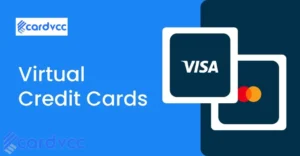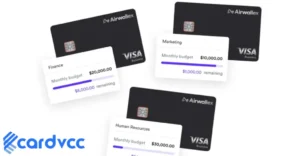A virtual credit card offers secure online transactions by generating temporary card numbers. It reduces the risk of fraud and unauthorized purchases.

Virtual credit cards have become essential in the digital age. These cards provide an extra layer of security for online shopping. They generate unique, temporary card numbers for each transaction. This ensures your primary card details remain safe. Businesses and individuals benefit from reduced fraud risk.
Virtual credit cards also offer better expense management. Many providers allow setting spending limits and expiration dates. This feature helps in controlling budgets effectively. Using virtual credit cards can enhance financial security and convenience. They are a smart choice for anyone concerned about online safety. The ease of setup and use makes them accessible to all.
Introduction To Virtual Credit Cards
Virtual credit cards are gaining popularity in the digital age. They offer a safe and convenient way to make online purchases. These cards are not physical but function like traditional credit cards. You can use them for online shopping, subscriptions, and more.
What Are Virtual Credit Cards?
Virtual credit cards are digital versions of traditional credit cards. They come with a unique card number, expiration date, and CVV. These details are used for online transactions. Unlike physical cards, they exist only in digital form. This makes them ideal for secure online payments.
Many banks and financial institutions offer virtual credit cards. They are often linked to your primary credit card. You can set spending limits and expiration dates. This helps in controlling your expenses and enhancing security. If the virtual card details get compromised, you can easily replace them without affecting your main account.
- Unique card number
- Expiration date
- CVV
- Linked to primary credit card
- Set spending limits
- Enhanced security
Brief History
The concept of virtual credit cards emerged in the early 2000s. They were created to address the growing concern of online fraud. Initially, they were offered by a few tech-savvy banks. Over time, their popularity grew as online shopping became widespread.
In the beginning, virtual credit cards had limited features. They were primarily used for single transactions. Modern virtual credit cards come with advanced features. These include adjustable spending limits and temporary card numbers. Today, many financial institutions offer virtual credit cards as part of their service portfolio.
| Feature | Description |
|---|---|
| Unique Card Number | A different number from your physical card |
| Expiration Date | Customizable expiration dates |
| CVV | Three-digit security code |
| Spending Limits | Set your spending limits |
| Enhanced Security | Ideal for online transactions |
Benefits For Consumers
Virtual credit cards offer numerous benefits for consumers. These benefits not only enhance security but also provide convenience and flexibility. Below, we explore these advantages in detail.
Enhanced Security
Virtual credit cards provide an added layer of security. Unlike physical cards, these cards use a unique, temporary number for each transaction. This feature minimizes the risk of fraud and identity theft. If someone steals your virtual card number, they can’t use it for another purchase.
Consumers can set spending limits on virtual cards. This control helps prevent unauthorized transactions. Furthermore, you can easily deactivate a virtual card. This feature offers peace of mind for online shoppers.
Convenience And Flexibility
Virtual credit cards offer unmatched convenience. You can generate a new card number in seconds. This is especially useful for online shopping. No need to wait for a physical card to arrive.
These cards provide flexibility in managing your finances. You can create multiple virtual cards for different purposes. For example, use one for subscriptions and another for one-time purchases. This separation makes tracking expenses easier.
| Benefit | Description |
|---|---|
| Enhanced Security | Unique, temporary numbers for each transaction |
| Spending Limits | Set limits to prevent unauthorized transactions |
| Convenience | Generate new card numbers instantly |
| Flexibility | Create multiple cards for different purposes |
- Temporary numbers minimize fraud risk.
- Spending limits offer control over transactions.
- Instant generation of card numbers saves time.
- Multiple cards help in tracking expenses better.
- Virtual credit cards enhance security.
- They offer unmatched convenience.
- These cards provide great flexibility.
How Virtual Credit Cards Work
Virtual credit cards are a modern solution for secure online transactions. They offer a layer of protection by using temporary card numbers. These numbers mask your actual credit card details. Understanding how these cards work is essential for safe online shopping.
Generation Process
The generation of a virtual credit card is straightforward. Your bank or card provider offers this feature. You can generate a virtual card via their website or mobile app. The process involves:
- Logging into your account.
- Finding the virtual card section.
- Clicking on the generate button.
- Receiving a temporary card number.
This number usually comes with an expiration date and a CVV code. Both are essential for completing online transactions. The virtual card is linked to your real credit card. Charges on the virtual card reflect on your real card statement.
Usage In Online Transactions
Using a virtual credit card for online purchases is easy. When you shop online, use the temporary card number. Enter the expiration date and CVV code provided. The merchant processes the payment as usual. Your real card details remain hidden. This reduces the risk of fraud and unauthorized charges.
Virtual cards are ideal for:
- One-time purchases.
- Subscription services.
- Shopping on less secure websites.
They offer peace of mind and enhance security. You can also set spending limits on virtual cards. This helps manage your budget and prevents overspending.
Market Landscape
The virtual credit card business is evolving rapidly. The market landscape is shaped by various key players and emerging trends. Understanding these elements is crucial for businesses and consumers alike.
Key Players
Several companies dominate the virtual credit card market. Here are some of the key players:
- American Express: Offers robust virtual card services.
- MasterCard: Provides secure and reliable virtual cards.
- Visa: Known for global reach and strong security features.
- Capital One: Focuses on user-friendly virtual card solutions.
These companies provide a variety of features and services. They aim to enhance security and convenience for users.
Market Trends
The virtual credit card market is influenced by several trends. These trends are shaping the future of digital payments:
- Increased Security: Virtual cards offer enhanced security features.
- Global Adoption: More people are using virtual cards worldwide.
- Mobile Integration: Virtual cards are being integrated into mobile wallets.
- Customization: Users can customize limits and usage patterns.
These trends indicate a shift towards safer and more versatile payment options. Businesses need to adapt to these changes to stay competitive.
Here’s a quick overview of some key metrics:
| Aspect | Details |
|---|---|
| Security | Enhanced with tokenization and encryption. |
| Convenience | Easy integration with mobile wallets. |
| Global Reach | Adopted by users worldwide. |

Business Models
The virtual credit card business offers various business models. These models help companies earn revenue efficiently. Key models include Subscription-Based and Transaction Fee Models.
Subscription-based Models
In a subscription-based model, users pay a recurring fee. This fee grants them access to virtual credit cards. The subscription can be monthly, quarterly, or yearly. This ensures a steady income for the business.
Benefits of this model include:
- Predictable Revenue Stream: Businesses can forecast earnings easily.
- Customer Loyalty: Subscribers are likely to stay longer.
Challenges of this model include:
- High Customer Acquisition Cost: Attracting new subscribers can be costly.
- Retention Efforts: Keeping subscribers engaged requires effort.
Transaction Fee Models
In the transaction fee model, businesses earn from each transaction. Users pay a small fee whenever they use the virtual card. This model is flexible and scalable.
Advantages include:
- Scalability: Income grows with the number of transactions.
- Low Entry Barrier: Users pay only when they transact.
Drawbacks include:
- Revenue Unpredictability: Income can vary each month.
- Transaction Volume Dependency: Revenue depends on user activity.
| Model | Advantages | Drawbacks |
|---|---|---|
| Subscription-Based | Predictable Revenue, Customer Loyalty | High Acquisition Cost, Retention Efforts |
| Transaction Fee | Scalability, Low Entry Barrier | Revenue Unpredictability, Volume Dependency |
Challenges And Risks
The virtual credit card business offers many benefits. Yet, it also faces several challenges and risks. These challenges include fraud prevention and regulatory compliance. Understanding these risks is crucial for businesses in this space.
Fraud Prevention
Fraud is a significant issue in the virtual credit card industry. Protecting user data and funds is vital. Businesses must implement robust security measures. These include encryption and multi-factor authentication.
Encryption ensures that data is secure during transmission. It converts data into a code to prevent unauthorized access.
Multi-factor authentication adds an extra layer of security. It requires users to verify their identity in multiple ways.
A table summarizing common fraud prevention techniques:
| Technique | Description |
|---|---|
| Encryption | Transforms data into code for security |
| Multi-factor Authentication | Verifies identity using multiple methods |
| Real-time Monitoring | Tracks transactions instantly to detect fraud |
| AI and Machine Learning | Uses algorithms to identify suspicious patterns |
Regulatory Compliance
Compliance with regulations is another major challenge. Different regions have different rules. Businesses must stay updated with local laws. Failure to comply can result in hefty fines.
Key regulations include:
- PCI DSS: Standards for secure handling of card information.
- GDPR: Protects personal data in the European Union.
- CCPA: California’s privacy law for consumer data protection.
Adhering to these regulations ensures business integrity. It also builds customer trust.
A simple checklist for regulatory compliance:
- Understand local and international regulations.
- Implement necessary security measures.
- Regularly update compliance protocols.
- Train staff on compliance requirements.
Ensuring compliance can be challenging. Yet, it is essential for the success of a virtual credit card business.
Future Prospects
The future of the Virtual Credit Card Business holds immense potential. The industry is set to revolutionize how transactions are made. Let’s explore some key aspects that will shape its future.
Technological Innovations
Technological advancements are driving the growth of virtual credit cards. Artificial Intelligence (AI) and Machine Learning (ML) are enhancing security. These technologies detect and prevent fraudulent activities in real-time.
Blockchain technology is another game-changer. It ensures transparency and immutability. Blockchain reduces transaction times and costs. It also enhances security features, making virtual credit cards more reliable.
Mobile payments are on the rise. With smartphones, users can generate virtual cards instantly. This convenience is attracting more users to the virtual credit card space.
Potential Market Expansion
The market for virtual credit cards is expanding rapidly. More businesses are adopting virtual cards for their transactions. This trend is particularly strong among e-commerce platforms.
Emerging markets in Asia and Africa show significant growth potential. These regions are witnessing increased internet penetration. As more people get online, the demand for virtual credit cards will surge.
Partnerships with financial institutions are key. Banks and fintech companies are collaborating to offer virtual credit cards. This increases the reach and adoption of the technology.
| Region | Growth Potential |
|---|---|
| Asia | High |
| Africa | Moderate |
| North America | Stable |
| Europe | Stable |
Government policies are becoming more favorable. Regulations are being adapted to support virtual credit card usage. This creates a conducive environment for growth.
As awareness increases, more consumers are opting for virtual credit cards. Their convenience, security, and ease of use are major factors driving this trend.
Case Studies
Exploring Case Studies in the Virtual Credit Card Business can provide valuable insights. These real-world examples highlight successful implementations and the lessons learned.
Successful Implementations
Many companies have seen great success with virtual credit cards. These cards offer a safe and easy payment method. Here are a few notable examples:
| Company | Implementation | Result |
|---|---|---|
| XYZ Corp | Integrated virtual cards for employee expenses | Reduced fraud by 70% |
| ABC Ltd | Used virtual cards for vendor payments | Cut down processing time by 50% |
Lessons Learned
From these cases, we gather some important lessons. Implementing virtual credit cards requires careful planning. Here are the key takeaways:
- Always train employees on how to use virtual cards.
- Monitor transactions regularly to catch any irregularities.
- Work closely with your card provider to resolve issues.
- Ensure your system is secure to protect against fraud.
By studying these case studies, businesses can better understand the benefits and challenges. This knowledge helps in making informed decisions.

Frequently Asked Questions
What Is A Virtual Credit Card?
A virtual credit card is a digital version of a physical card. It allows secure online transactions without exposing your actual card details.
How Does A Virtual Credit Card Work?
A virtual credit card generates a unique card number for each transaction. This minimizes fraud and enhances online security.
Are Virtual Credit Cards Safe?
Yes, virtual credit cards are safe. They provide an extra layer of security by masking your real card information during transactions.
Can I Use A Virtual Credit Card Anywhere Online?
You can use a virtual credit card at most online retailers. However, some sites might not accept them, so check beforehand.
Conclusion
Virtual credit cards offer enhanced security and convenience for online transactions. They help protect your personal information. Businesses can benefit from reduced fraud and streamlined payments. As digital commerce grows, adopting virtual credit cards becomes essential. Embrace this technology to stay ahead in the competitive market.







